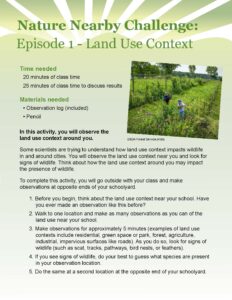1 Classroom Period

In this article, scientists examine different land uses, from urban to suburban to rural landscapes, and their effects on wildlife.…
In this article, scientists examine different land uses, from urban to suburban to rural landscapes, and their effects on wildlife. In particular, the scientists examine how different features of these...

In this FACTivity, you will observe the land use context around you. Materials: Observation log (included) Pencil or other writing…
In this FACTivity, you will observe the land use context around you. Materials: Observation log (included) Pencil or other writing utensil Scientists, like those in this study, are trying to...

After watching episode 3 of Ecosystems LIVE about investigating the animals that live near you, try this Nature Nearby Challenge.…
After watching episode 3 of Ecosystems LIVE about investigating the animals that live near you, try this Nature Nearby Challenge. In this activity, you will use your senses to make...

After watching episode 2 of Ecosystems LIVE about human impacts on insects, you can try this Nature Nearby Challenge. In…
After watching episode 2 of Ecosystems LIVE about human impacts on insects, you can try this Nature Nearby Challenge. In this activity, you’ll simulate the act of pollination using snack...

After watching episode 1 of Ecosystems LIVE about human impacts on mammals, you can try this Nature Nearby Challenge. In…
After watching episode 1 of Ecosystems LIVE about human impacts on mammals, you can try this Nature Nearby Challenge. In this activity, you will observe the land use context around...

In this lesson plan, students will use clues from Natural Inquirer Readers to determine what makes a scientist a scientist. Students…
In this lesson plan, students will use clues from Natural Inquirer Readers to determine what makes a scientist a scientist. Students will create an anchor chart of scientist characteristics for future...

In this study, researchers worked with middle and high school students to collect moss samples around industrial neighborhoods in Seattle,…
In this study, researchers worked with middle and high school students to collect moss samples around industrial neighborhoods in Seattle, Washington. They used the moss samples to both pinpoint pollution...

In this FACTivity, you will make a graph of the Air Quality Index numbers for each of five major cities…
In this FACTivity, you will make a graph of the Air Quality Index numbers for each of five major cities in the United States for November 2023. Materials: Blank graph...

In this lesson plan, students will examine some of our Readers to identify features of nonfiction texts (e.g. table of…
In this lesson plan, students will examine some of our Readers to identify features of nonfiction texts (e.g. table of contents, maps, glossaries, boldfaced words, etc.). Together with your students,...

In this lesson plan, students will explore the differences between fiction and nonfiction using a Venn diagram to visualize their…
In this lesson plan, students will explore the differences between fiction and nonfiction using a Venn diagram to visualize their comparison. Students will use a variety of nonfiction texts (like...










